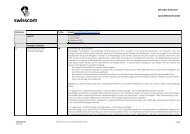Shareholders' Letter
Shareholders' Letter
Shareholders' Letter
You also want an ePaper? Increase the reach of your titles
YUMPU automatically turns print PDFs into web optimized ePapers that Google loves.
LAN (Local Area Network)<br />
A LAN is a local network for interconnecting computers, usually based on Ethernet.<br />
LTE (Long Term Evolution)<br />
The successor technology to HSPA. LTE enables mobile broadband data speeds of up to 300 Mbps.<br />
MVNO (Mobile Virtual Network Operator)<br />
MVNO is a business model for mobile communications in which a company (the MVNO) with no<br />
network infrastructure or a limited network infrastructure is able to access the infrastructure of<br />
other mobile communications providers.<br />
Optical fibre<br />
Optical fibre is used as a transport medium for optical data transmission.<br />
PSTN (Public Switched Telephone Network)<br />
PSTN is a collective term that covers the public fixed telephone network in its entirety.<br />
PWLAN (Public Wireless Local Area Network)<br />
A PWLAN is a public local area network that enables data access using different wireless transmission<br />
technologies. Swisscom customers can use more than 1,200 hotspots in Switzerland and<br />
over 65,000 worldwide. All that is required is a laptop, PDA or mobile telephone, a WLAN card and<br />
access via a telecommunications provider. Maximum transmission capacity in the PWLAN is 2<br />
Mbps.<br />
Roaming<br />
The term “roaming” originally comes from the GSM world.<br />
Traditional GSM roaming is defined as the ability of a mobile network subscriber to make and<br />
receive automatic calls in a network other than their own, to automatically send and receive data<br />
or have access to other mobile network services. Roaming enables mobile network subscribers to<br />
use their mobile phones when travelling abroad. The mobile telephone of a subscriber outside<br />
Switzerland automatically selects the best-quality partner network. Information indicating the<br />
country and region where the mobile phone is located at any given time is sent to the exchange<br />
in Switzerland where the mobile phone is registered. On receipt of the calling signal, the exchange<br />
in Switzerland transmits it within a fraction of a second to the right region in the respective country,<br />
where the signal is forwarded to the base station in whose vicinity the mobile phone is located.<br />
The base station then forwards the signal to the mobile phone and the call can be taken. Roaming<br />
only works if all countries involved operate on the same frequency bands. In Europe all GSM networks<br />
use the same frequency bands. Other countries such as the USA or countries in South America<br />
use a different frequency range. Most mobile telephones today are triband or quadband and<br />
support 900 MHz and 1800 MHz networks (which are most commonly used in Europe) as well as<br />
850 MHz and 1900 MHz networks.<br />
Router<br />
A router is a device for combining or separating several computer networks. The router analyses<br />
incoming data packets according to their destination address, and either blocks them or forwards<br />
them accordingly (packet routing).<br />
Further Information 228 | 229<br />
Glossary



